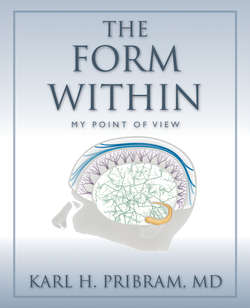Читать книгу The Form Within - Karl H Pribram - Страница 43
На сайте Литреса книга снята с продажи.
A Show of Hands
ОглавлениеTo illustrate how such a network might function, I ask the students in my class to do the following: “All those who are wearing blue jeans, please raise your hand. Look at the distribution of hands. Now lower them. Next, all those wearing glasses, please raise your hands. Look at the distribution of hands and note how different it is from the distribution produced by those wearing blue jeans.” Again, “All girls, raise your hands; then all boys.” We quickly observe that each distribution, each pattern, is different. The features—blue jeans, glasses, gender—were coded by the various patterns of raised hands, a pattern within a web, not by the characteristic of only a single individual person,
Brain cells are like people when you get to know them. Each is unique. All features are distributed among the group of individuals, but not all the individuals share all the features. Also, as in the saying “birds of a feather flock together,” brain cells sharing the same grouping of features tend to form clusters. Thus, one cluster will have more cells that are sensitive to color; another cluster will have more cells that are sensitive to movement. Still, there is a great deal of overlap of features within any cluster. People are the same in many respects. For instance, some of us have more estrogen circulating in our bodies while others have more testosterone. But all of us have some of each.
With this arrangement of “features as patterns,” the question immediately arises as to who asks the question as I did with my students: Who is wearing blue jeans? This question is known as an example of a top-down approach to processing, whereas feature detection is a bottom-up approach. In my laboratory, my colleagues and I spent the better part of three decades establishing the anatomy and physiology of the routes by which top-down processing occurs in the brain. Together with the results of other laboratories, we demonstrated that electrical stimulation of the sensory-specific “association” regions of the brain cortex changed the patterns of response of sensory receptors to a sensory input. Influence of such stimulation was also shown to affect all the “way stations” that the sensory input traversed en route to the sensory receiving cells in the cortex.
Even more surprising was the fact that the effects of an auditory or touch stimulus would reach the retina in about the same amount of time that it takes for a visual stimulus to be processed. Tongue in cheek, I’ve noted these results in the phrase: “We live in our sensory systems.” The experimental findings open the important question as to where all our processing of sensory input begins, and what is the sequence of processing. That question will be addressed shortly and again in depth when we analyze frames and contexts.
